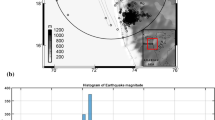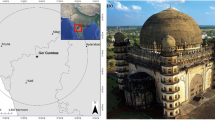Abstract
The Himalayan region has undergone significant development and to ensure safe and secure progress in such a seismically vulnerable region there is a need for hazard assessment. For seismic hazard assessment, it is important to assess the quality, consistency, and homogeneity of the seismicity data collected from different sources. In the present study, an improved magnitude conversion technique has been used to convert different magnitude scales to moment magnitude scale. The study area and its adjoining region have been divided into 22 seismogenic zones based upon the geology, tectonics, and seismicity including source mechanism relevant to the region. Region specific attenuation equations have been used for seismic hazard assessment. Standard procedure for PSHA has been adopted for this study and peak ground motion is estimated for 10% and 2% probability of exceedance in 50 years at the bed rock level. For the 10% and 2% probability of exceedance in 50 years, the PGA values vary from 0.06 to 0.36 g and 0.11 to 0.65 g, respectively considering varying b-value. Higher PGA values are observed in the southeast part region situated around Kaurik Fault System (KFS) and western parts of Nepal.





Similar content being viewed by others
References
Akkar S and Bommer J J 2010 Empirical equations for the prediction of PGA, PGV, and spectral accelerations in Europe, the Mediterranean region, and the Middle East; Seismol. Res. Lett. 81 195–206.
Bhatia S C, Kumar R M and Gupta H K 1999 A probabilistic seismic hazard map of India and adjoining regions; Ann. Geofis. 42 (6) 1153–1164.
BIS Code 1893 2002 Earthquake hazard zoning map of India; www.bis.org.in.
Boore D M and Atkinson G M 2008 Ground-motion prediction equations for the average horizontal component of PGA, PGV, and 5% damped PSA at spectral periods between 0.01s and 10.0s; Earthquake Spectra 24 99–138.
Campbell K W and Bozorgnia Y 2008 NGA ground motion model for geometric mean horizontal component of PGA, PGV, PGD and 5% damped linear elastic response spectra for periods ranging from 0.01 to 10s; Earthquake Spectra 24 (1) 139–171.
Chiou B S J and Youngs R R 2008 Empirical ground motion model for the average horizontal component of peak acceleration and pseudo-spectral acceleration for spectral periods of 0.01 to 10 seconds; Earthquake Spectra 24 (S1) 173–216.
Cornell C A 1968 Engineering seismic risk analysis; Bull. Seismol. Soc. Am. 58 1583–1606.
Das R, Wason H R and Sharma M L 2012a Magnitude conversion to unified moment magnitude using orthogonal regression relation; J. Asian Earth Sci. 50 (2) 44–51.
Das R, Wason H R and Sharma M L 2012b Temporal and spatial variations in the magnitude of completeness for homogenized moment magnitude catalog for northeast India; J. Earth Syst. Sci. 121 (1) 19–28.
Das R, Wason H R and Sharma M L 2013 General orthogonal regression relation between body and moment magnitudes; Seismol. Res. Lett. 84 (2) 219–224.
Development of probabilistic seismic hazard map of India 2011 Technical Report, National Disaster Management Authority (NDMA), Government of India, New Delhi.
Gansser A 1977 The great suture zone between Himalaya and Tibet: A preliminary note; AccSci Terre Himalayas CNRS 268 181–192.
Gardner J K and Knopoff L 1974 Is the sequence of earthquakes in southern California, with aftershocks removed, Poissonian? Bull. Seismol. Soc. Am. 64 1363–1367.
GSI 2000 Seismotectonic Atlas of India and its Environs; Geological Survey of India.
Gupta I D 2006 Delineation of probable seismic sources in india and neighbourhood by a comprehensive analysis of seismotectonic characteristics of the region; Soil Dynam. Earthquake Eng. 267 766–790.
Gutenberg B and Richter C F 1944 Frequency of Earthquakes in California; Bull. Seismol. Soc. Am. 34 (4) 1985–1988.
Iyengar R N, Sharma D and Siddiqui J M 1999 Earthquake history of India in medieval times; Ind. J. Hist. Sci. 34 (3) 181–237.
Joshi G C and Sharma M L 2008 Uncertainties in the 679 estimation of M max; J. Earth Syst. Sci. 117 671–682.
Khattri K N, Rogers A M, Perkins D M and Algermissen S T 1984 A seismic hazard map of India and adjacent area; Tectonophys. 108 93–134.
Kijko A 2004 Estimation of the maximum earthquake 681 magnitude, M max; Pure Appl. Geophys. 161 1655–1681.
Kramer S L 2003 Geotechnical Earthquake Engineering, Prentice Hall International Series, Pearson Education, Delhi, Chapter 4.
Mahajan A K, Thakur V C, Sharma M L and Chauhan M 2010 Probabilistic seismic hazard map of NW Himalaya and its adjoining area, India; Nat. Hazards 53 443–457.
Nath S K and Thingbaijam K K S 2012 Probabilistic seismic hazard assessment of India; Seismol. Res. Lett. 83 135–149.
Nath S K and Thingbaijam K K S 2011 Peak ground motion predictions in India: An appraisal for rock sites; J. Seismol. 15 295–315.
Oldham T 1883 A catalog of Indian earthquakes from the earliest times to the end of 1869 AD; Geol. Surv. India Memoir, XIX Part-3.
Ordaz M, Aguilar A and Arboleda J 2003 CRISIS 2003: Program for computing seismic hazard, Ver. 3.01.
OrdazM,Martinelli F, Aguitar A, Arboleda J, Meletti C and Amico V D 2012 CRISIS 2007: Program for computing seismic hazard, Ver. 4.4, Instituto de Ingenieria, UNAM, Mexico.
Parvez I A, Vaccari F and Panza G F 2003 A deterministic seismic hazard map of India and adjacent areas; Geophys. J. Int. 155 (2) 489–508.
Patil N S, Das J D, Kumar A, Rout M M and Das R 2014 Probabilistic seismic hazard assessment of Himachal Pradesh and adjoining regions; J. Earth Syst. Sci. 123 (1) 49–62.
Ristau J 2009 Comparison of magnitude estimates for New Zealand earthquakes: Moment magnitude, local magnitude, and teleseismic body-wave magnitude; Bull. Seismol. Soc. Am. 99 1841–1852.
Ristau J, Rogers G C and Cassidy J F 2005 Moment magnitude–local magnitude calibration for earthquakes in western Canada; Bull. Seismol. Soc. Am. 95 1994– 2000.
Sarlis N V, Skordas E S, Lazaridou M S and Varotsos P A 2008 Investigation of seismicity after the initiation of a seismic electric signal activity until the main shock; Proc. Jpn. Acad. Ser. B 84 331–343.
Sarlis N V, Skordas E S, Varotsos P A, Nagao T, Kamogawa M, Tanaka H and Uyeda S 2013 Minimum of the orderparameter fluctuations of seismicity before major earthquakes in Japan; Proc. Natl. Acad. Sci. USA 110 (34) 13,734–13,738.
Tanaka H, Varotsos P A, Sarlis N V and Skordas E S 2004 A plausible universal behavior of earthquakes in the natural time-domain; Proc. Jpn. Acad. Ser. A 80 283–289.
Thingbaijam K K S, Nath S K, Yadav A, Raj A, Walling M Y and Mohanty W K 2008 Recent seismicity in northeast India and its adjoining region; J. Seismol. 12 107–123.
Valdiya K S 1980 Geology of Kumaun Lesser Himalaya; Wadia Institute of Himalayan Geology, Dehradun, pp. 290–291.
Varotsos P A, Sarlis N V, Skordas E S and Lazaridou M S 2013 Seismic electric signals: An additional fact showing their physical interconnection with seismicity; Tectonophys. 589 116–125.
Wason H R, Das R and Sharma M L 2012 Magnitude conversion problem using general orthogonal regression; Geophys. J. Int. 190 (2) 1091–1096.
Wiemer S and Wyss M 2001 ZMAP: A Tool for Analyses of Seismicity Patterns. A cookbook; 57p.
Woessner J and Wiemer S 2005 Assessing the quality of earthquakes catalogs: Estimating the magnitude of completeness and its uncertainty; Bull. Seismol. Soc. Am. 95 (2) 684–698.
Zhao J X, Zhang J, Asano A, Ohno Y, Oouchi T, Takahashi T, Ogawa H, Irikura K, Thio H K, Somerville P G, Fukushima Y and Fukushima Y 2006 Attenuation relations of strong ground motion in Japan using site classification based on predominant period; Bull. Seismol. Soc. Am. 96 (3) 898–913.
Acknowledgements
Earthquake data from India Meteorological Department, India, US Geological Survey, USA and International Seismological Centre, On-line Bulletin, United Kingdom catalogs have been used in this study and the authors remain grateful for their support. The first author is thankful to MHRD, Govt. of India for PhD Fellowship.
Author information
Authors and Affiliations
Corresponding author
Rights and permissions
About this article
Cite this article
Rout, M.M., Das, J., Kamal et al. Probabilistic seismic hazard assessment of NW and central Himalayas and the adjoining region. J Earth Syst Sci 124, 577–586 (2015). https://doi.org/10.1007/s12040-015-0565-x
Received:
Revised:
Accepted:
Published:
Issue Date:
DOI: https://doi.org/10.1007/s12040-015-0565-x




